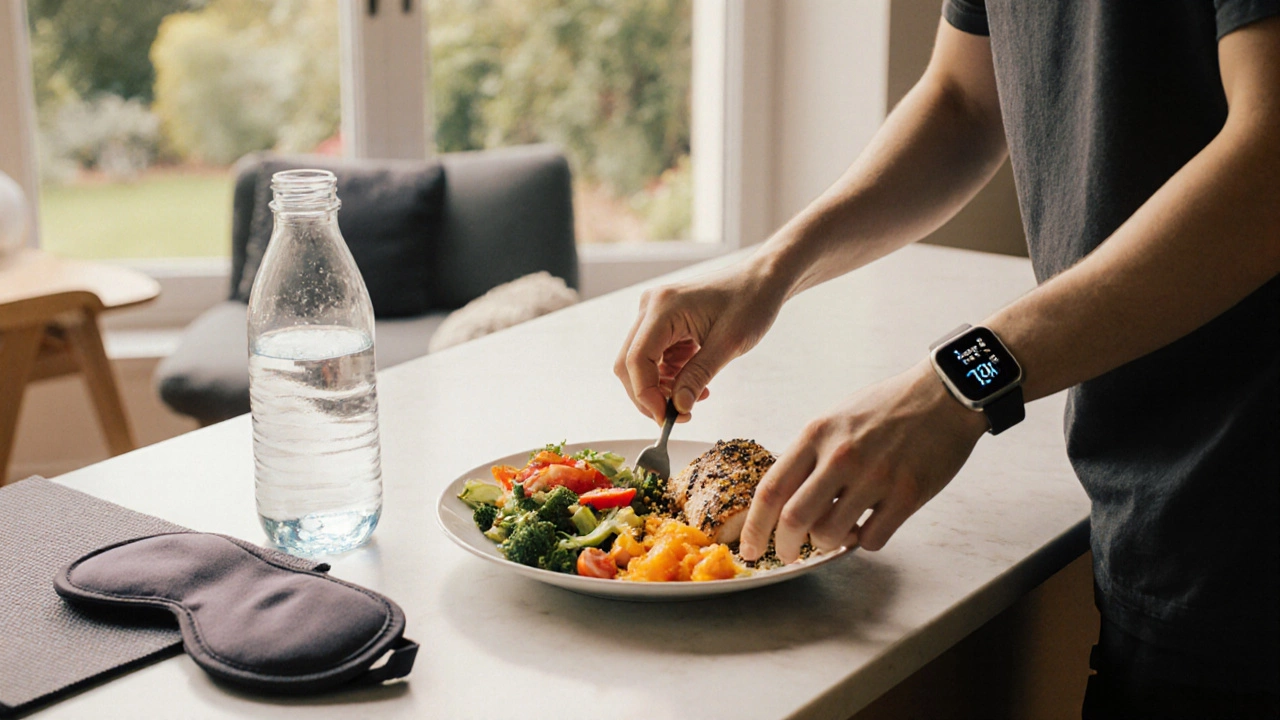Simple Steps to Get Fit and Stay Healthy

Fitness Progress Tracker
Daily Fitness Checklist
Weekly Progress
Consistency is key! Track your progress daily to see improvements over time.
Try to meet all targets for at least 4 days per week for best results.
Ever wonder why some people seem to breeze through life with energy, a strong body, and a clear mind while you’re stuck feeling sluggish? The secret isn’t a magic pill - it’s a set of practical habits that anyone can adopt. Below you’ll find a step‑by‑step guide that turns vague ideas about "being fit" into concrete actions you can start today.
Understanding Fitness Basics
Fitness is a state of physical health achieved through regular activity, proper nutrition, and adequate recovery. It isn’t just about looking good; it’s about feeling good, moving efficiently, and reducing disease risk.
Fitness breaks down into four pillars: cardiovascular endurance, muscular strength, flexibility, and body composition. Ignoring any one pillar limits progress. Think of your body as a car - you need a strong engine (cardio), sturdy chassis (strength), smooth steering (flexibility), and the right fuel (nutrition) to run well.
Build a Balanced Workout Routine
Most beginners ask, "What should I do first?" The answer: blend Cardiovascular Exercise activities like brisk walking, jogging, cycling, or swimming that elevate heart rate with Strength Training resistance work using weights, bands, or bodyweight that builds muscle fibers. A weekly template that works for most people looks like this:
- Monday - 30minutes moderate‑intensity cardio (e.g., jog or bike).
- Tuesday - Full‑body strength session (3 sets of 8‑12 reps for major lifts).
- Wednesday - Active recovery: yoga or a light walk.
- Thursday - 20‑minute interval cardio (30seconds sprint, 90seconds jog, repeat).
- Friday - Strength focus on upper body and core.
- Saturday - Outdoor activity you enjoy (hike, sports, dance).
- Sunday - Rest or gentle stretching.
When you’re new, start with 20‑minute sessions and gradually increase duration or intensity. Consistency beats intensity; a 15‑minute walk five days a week is more effective than a single marathon‑style session.
Flexibility shouldn’t be an afterthought. Adding at least 5‑10 minutes of dynamic stretches before workouts and static stretches afterward keeps joints healthy and reduces injury risk. If you need a quick guide, try the following:
- Hip flexor stretch - 30seconds each side.
- Chest opener - 30seconds.
- Hamstring stretch - 30seconds each leg.
Nutrition that Fuels Your Body
Balanced Diet a pattern of eating that provides adequate macronutrients, micronutrients, and fiber while limiting excess sugars and processed foods is the fuel that determines how well your workouts translate into results. Here are three core principles:
- Prioritize protein. Aim for 1.2‑2.0g per kilogram of body weight daily. Good sources include lean chicken, beans, Greek yogurt, and tofu.
- Choose complex carbs. Whole grains, sweet potatoes, and legumes supply steady energy without the crash of refined sugars.
- Don’t forget healthy fats. Avocado, nuts, and olive oil support hormone production and joint health.
Most people stumble on portion control. A simple visual trick: fill half your plate with vegetables, a quarter with protein, and a quarter with whole‑grain carbs. Pair meals with a glass of water and you’ll also hit the next pillar.

Recovery: Sleep, Hydration, and Stress Management
Recovery is often the missing link for those who train hard but see little progress. Three recovery factors have the biggest impact:
- Sleep 7‑9 hours of uninterrupted rest that supports muscle repair, hormone balance, and memory consolidation. Aim for a consistent bedtime, dark room, and limited screen exposure.
- Hydration adequate fluid intake that maintains blood volume, temperature regulation, and nutrient transport. A practical rule: drink half your body weight in ounces of water each day, plus extra for vigorous workouts.
- Stress Management. Chronic cortisol spikes can sabotage muscle growth and increase belly fat. Techniques like deep breathing, meditation, or a 10‑minute walk in nature lower stress quickly.
Tracking sleep quality with a phone app or wearable helps you see patterns. If you notice frequent waking, assess caffeine intake, screen time, and bedroom temperature.
Tracking Progress & Staying Motivated
Measuring results keeps you honest and fuels motivation. Choose two or three metrics that matter to you:
- Body composition - use a smart scale or skinfold calipers every month.
- Performance - record run times, lifted weight, or number of push‑ups.
- Energy levels - rate daily stamina on a 1‑10 scale.
Enter data into a simple spreadsheet or a free app like MyFitnessPal for nutrition and Strava for cardio. When you see trends, adjust your plan: more cardio if stamina stalls, more strength if muscle gain slows.
Motivation also thrives on community. Join a local fitness class, find a workout buddy, or participate in a virtual challenge. The social accountability factor can boost adherence by up to 40%.

Common Mistakes to Avoid
Even well‑intentioned people trip over a few classic pitfalls:
- All‑or‑nothing mindset. Skipping a workout after a missed meal leads to a cascade of missed days.
- Over‑reliance on gadgets. Numbers are useful, but don’t let the scale dictate self‑worth.
- Ignoring joint health. Neglecting warm‑ups or mobility work causes chronic pain.
- Under‑eating. Cutting calories too aggressively reduces metabolic rate and muscle mass.
Address each by planning realistic weekly goals, balancing data with how you feel, and listening to your body’s signals.
Quick Checklist - Your Daily Fitness Blueprint
- Move for at least 30minutes (cardio or strength).
- Eat protein at every meal.
- Fill half your plate with vegetables.
- Drink water - aim for Hydration guidelines.
- Get 7‑9 hours of Sleep.
- Take 5‑10 minutes for flexibility work.
- Log one metric (weight, run time, or energy score).
Follow this list for a month and you’ll notice more stamina, clearer skin, and a steadier mood. Remember, the goal isn’t perfection; it’s consistent improvement.
| Aspect | Cardiovascular Exercise | Strength Training | Flexibility/Mobility |
|---|---|---|---|
| Primary Goal | Improve heart and lung capacity | Increase muscle mass and power | Enhance joint range of motion |
| Typical Session Length | 20‑60min | 30‑45min | 5‑15min |
| Key Health Benefits | Lower blood pressure, better cholesterol | Higher basal metabolic rate, stronger bones | Reduced injury risk, better posture |
| Best For | Weight control, endurance athletes | Muscle tone, athletes needing power | Seniors, people with tight muscles |
Frequently Asked Questions
How many days a week should I work out?
Aim for at least three days of mixed cardio and strength. If time is limited, even two 30‑minute sessions can produce noticeable gains when paired with daily movement.
Do I need a gym membership?
No. Bodyweight circuits, resistance bands, and outdoor cardio provide everything you need. A gym can add variety, but isn’t essential for getting fit.
What’s the best time of day to exercise?
Choose the time you can stick to consistently. Morning workouts boost metabolism and mood for the day; evening sessions can help release stress after work.
How much water should I drink on workout days?
A good rule is 0.5-1ounce of water per pound of body weight, plus an extra 12‑16oz for each hour of intense activity.
Can I lose weight without counting calories?
Yes, if you focus on whole‑food portions, limit sugary drinks, and stay active. Mindful eating combined with a structured workout plan often yields steady weight loss without strict tracking.



